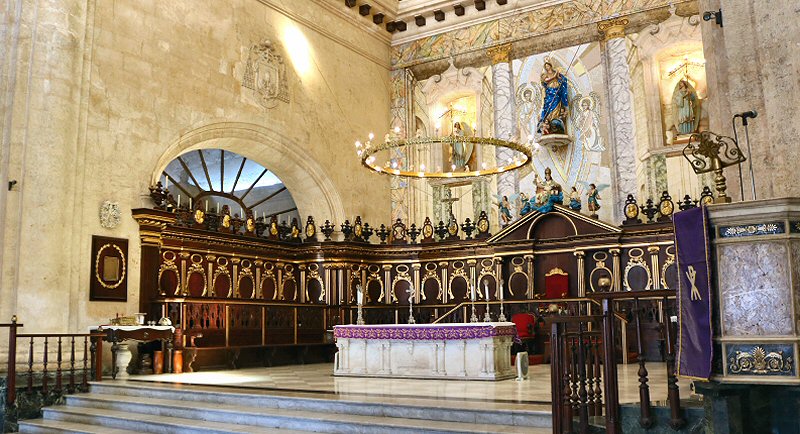
The cathedral, one of the oldest
cathedrals in the Americas, is the most prominent building
in the Plaza de la Catedral.
The façade of the cathedral is in
baroque style. It was designed by the Italian architect
Francesco Borromini that has also inspired by the trendy
Italian Tuscany style of architecture. The detail of the
façade resembles to the façade of the building of the
Colegio Seminario de San Carlos that was constructed also by
the Jesuits in the same period. It features many curved
edges that turn into column-like pilaster structures. In
contrast to the elaborated façade, the lateral façade of the
cathedral is rather simple one.
The surface of the outer walls is rough and has many hollows due to the conchifera (class of Mollusca with bivalve shells), embedded into the limestone that gives a rustic appearance, raw and natural. If you will look carefully, you will see fossils of marine flora, such as corals, in the stone of the building, like in the other buildings of the time. These stones were cut and hauled from the edge of the sea by the slaves. The façade is devoid of the profuse sculpted ornamentation that is usual in the other cathedrals, maybe due to the rustic materials that were used.
The two bell towers on each side of the building are different in size, creating a noticeable asymmetry at the detailed façade. The right one that has two bells, is somewhat wider than the left one that has not any bell, but a clock. The asymmetry between the bell towers that is very unusual to baroque style architecture, was the result of the obligation to make way for the water to flow freely that tended to accumulate in the swampy area. The cathedral is considered the only example of a baroque construction that shows distinctive asymmetrical features in Cuba. According to the legend, the two bells of the taller tower were cast by mixing gold and silver to the bronze to obtain a pleasant tone. A spiral stone staircase leads to the top of the bell tower, where the Capitolio and the other side of the bay can be photographed.
The cathedral has square openings. This feature that diverges from the classical buildings of those days, has been adopted to many new buildings in Cuba. As the church was not intended to be a city cathedral initially, it is not so large compared to the other cathedrals in the Americas: it occupies a rectangular area of 34 m x 36 m.
The dome has orange color.
In contrast to the ornamented exterior, the neoclassical interior of the cathedral is much simpler. In fact, the simplicity of the interior of the cathedral is the result of the reforms made by Juan José Díaz de Espada y Fernández de Landa, the second bishop of Havana (1802-1832). In his time the church was cleaned off all the objects, considered tasteless and gaudery, including the paintings, statues and altars. He was a fervent admirer of neoclassicism.
The floor is paved with black and
white marble.
There are three naves, covered with
wooden vaults, and eight side chapels. Two rows of four
stone columns separate the nave from the aisles. Its
impressive vaulted ceilings are breathtaking. The original
wooden ceilings were plastered in the period of Bishop
Espada.
The chapel of the Nuestra Señora de Loreto (Our Lady of Loreto) was consecrated by the Bishop Morell de Santa Cruz in 1755. The House of Loreto or Santa Casa is a building that was originally in Nazareth, Palestine, and was the place where the archangel Gabriel announced to the Virgin Mary that he was going to conceive a son, the son of God. Mary lived in this house until the death of Christ.
A huge chandelier hangs from the
dome.
In the period of Bishop Espada the
baroque altars were replaced by neoclassical ones. The main
altar is made of elaborate marble.
The wooden sculpture of the Saint
Christopher, Patron Saint of Havana, is the oldest item in
the cathedral, made by Martín de Andújar Cantos in Seville
in 1632.
The sculptures, goldsmithing of the
greater altar, and the tabernacle works were made by the
Italian master Bianchini with the collaboration of the
famous Spanish sculptor Antonia Solá in Rome in 1820.
The three fading frescoes above the main and relatively austere altar are the works of the Italian artist Giuseppe Perovanni, a neoclassical artist. He was commissioned by Bishop Juan José Díaz de Espada y Fernánez de Landa to paint three scenes: The Delivery of the Keys, The Last Supper and The Ascension. These original works date back to the late 18th century.
The eight grandiose framed oil paintings by the French artist Jean Baptiste Vermay, adorning the side walls, are the copies of the works of Peter Paul Rubens and Bartolomé Esteban Murillo, both Baroque artists. The original works can be found in cathedrals around Rome and in various museums. Jean Baptiste Vermay was commissioned by Bishop José Díaz de Espada to replace those works he considered to be in bad taste.
The cathedral has also several graves of locally renowned personalities, buried earlier than the Republic.
